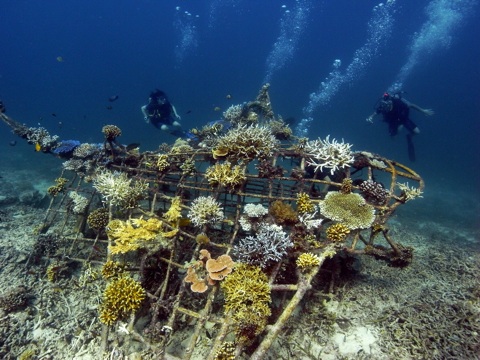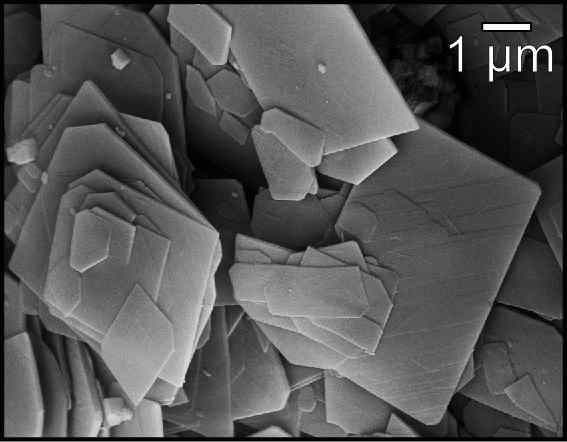|
Biorock
Biorock (also seacrete) is a cement-like engineering material formed when a small electric current is passed between underwater metal electrodes placed in seawater causing dissolved minerals to accrete onto the cathode to form a thick layer of limestone. This 'accretion process' can be used to create building materials or to create artificial 'electrified reefs' for the benefit of corals and other sea-life. Discovered by Wolf Hilbertz in 1976, biorock was protected by patents and a trademark which have now expired. History During the 1970s Professor Wolf Hilbertz, an architect by training, was studying seashells and reefs at the School of Architecture at the University of Texas. He was thinking about how humans could emulate the way coral grow. After preliminary work in 1975, in 1976 he discovered that by passing electric currents through salt water, over time a thick layer of various materials including limestone deposited on the cathode. Later experiments showed that the ... [...More Info...] [...Related Items...] OR: [Wikipedia] [Google] [Baidu] |
Wolf Hilbertz
Wolf Hartmut Hilbertz (April 16, 1938August 11, 2007) was a German-born futurist architect, inventor, and Oceanography, marine scientist. Notable contributions to science include the discovery of artificial mineral accretetion / biorock and its use to create electrified reefs. Personal life Early life Wolf Hilbertz was born in Gütersloh, (Germany) in 1938, the first child of Rudolf Hilbertz (1909–1995) and Erna Hilbertz, née Uslat (1906–2008). His parents had quite different personalities; whereas his father was artistic and inventive, thinking up one of the first Electric razor#Electric razors, electric razors, his mother had a more down to earth, practical approach. While his father would have liked to become an artist, circumstances forced him to start working in a bank, whereas his mother enjoyed her occupation, channeling her forceful personality into her job as a school teacher. After Wolf Hilbertz was born, the family moved to Ústí nad Labem, Ústí nad Labem / Auss ... [...More Info...] [...Related Items...] OR: [Wikipedia] [Google] [Baidu] |
Electrified Reef
An electric reef (also electrified reef) is an artificial reef made from biorock, being limestone that forms rapidly in seawater on a metal structure from dissolved minerals in the presence of a small electric current. The first reefs of this type were created by Wolf Hilbertz and Thomas J. Goreau in the 1980s. By 2011 there were examples in over 20 countries. History Artificial reefs have been built since the 1950s using materials including sunken ships, concrete blocks. While artificial reefs have been effective at boosting fish populations and are valuable areas for benthic organisms and other marine life (e.g. sponges) to colonise, they are less viable for coral restoration. due to the slow growth of corals and their susceptibility to environmental changes. In the 1970s, whilst studying how seashells and reefs grow, Wolf Hilbertz discovered a simple method of creating limestone from minerals dissolved in seawater, which he called biorock. Together with Thomas J. Gore ... [...More Info...] [...Related Items...] OR: [Wikipedia] [Google] [Baidu] |
Zoom On A Biorock Structure
Zoom may refer to: Technology Computing * Zoom (software), videoconferencing application * Page zooming, the ability to magnify or shrink a portion of a page on a computer display * Zooming user interface, a graphical interface allowing for image scaling * Digital zoom, an electronic emulation of a zoom lens Optics * Zoom ratio, the maximum relative to the minimum magnification factor of an optical system * Zoom lens, a lens system with a variable focal length, and hence variable magnification and angle of view * Zooming (filmmaking), a cinematographic effect Companies * Zoomcar, a carsharing company in India * Zoom (video game company), a Japanese video-game company * Zoom Airlines Inc., a former Canadian airline ** Zoom Airlines Limited, its former British sister company * Zoom Corporation, a Japanese audio company * ZOOM Erlebniswelt Gelsenkirchen, a zoological park in Gelsenkirchen, Germany * ZoomInfo (formerly Zoom Information), an American software company * Zoom Systems, a ... [...More Info...] [...Related Items...] OR: [Wikipedia] [Google] [Baidu] |
Carbon Sequestration
Carbon sequestration is the process of storing carbon in a carbon pool. Carbon dioxide () is naturally captured from the atmosphere through biological, chemical, and physical processes. These changes can be accelerated through changes in land use and agricultural practices, such as converting crop land into land for non-crop fast growing plants. Artificial processes have been devised to produce similar effects, including large-scale, artificial capture and sequestration of industrially produced using subsurface saline aquifers, reservoirs, ocean water, aging oil fields, or other carbon sinks, bio-energy with carbon capture and storage, biochar, enhanced weathering, direct air capture and water capture when combined with storage. Forests, kelp beds, and other forms of plant life absorb carbon dioxide from the air as they grow, and bind it into biomass. However, these biological stores are considered volatile carbon sinks as the long-term sequestration cannot be guaranteed. ... [...More Info...] [...Related Items...] OR: [Wikipedia] [Google] [Baidu] |
Atmosphere
An atmosphere () is a layer of gas or layers of gases that envelop a planet, and is held in place by the gravity of the planetary body. A planet retains an atmosphere when the gravity is great and the temperature of the atmosphere is low. A stellar atmosphere is the outer region of a star, which includes the layers above the opaque photosphere; stars of low temperature might have outer atmospheres containing compound molecules. The atmosphere of Earth is composed of nitrogen (78%), oxygen (21%), argon (0.9%), carbon dioxide (0.04%) and trace gases. Most organisms use oxygen for respiration; lightning and bacteria perform nitrogen fixation to produce ammonia that is used to make nucleotides and amino acids; plants, algae, and cyanobacteria use carbon dioxide for photosynthesis. The layered composition of the atmosphere minimises the harmful effects of sunlight, ultraviolet radiation, the solar wind, and cosmic rays to protect organisms from genetic damage. The current comp ... [...More Info...] [...Related Items...] OR: [Wikipedia] [Google] [Baidu] |
Carbon Dioxide
Carbon dioxide (chemical formula ) is a chemical compound made up of molecules that each have one carbon atom covalently double bonded to two oxygen atoms. It is found in the gas state at room temperature. In the air, carbon dioxide is transparent to visible light but absorbs infrared radiation, acting as a greenhouse gas. It is a trace gas in Earth's atmosphere at 421 parts per million (ppm), or about 0.04% by volume (as of May 2022), having risen from pre-industrial levels of 280 ppm. Burning fossil fuels is the primary cause of these increased CO2 concentrations and also the primary cause of climate change.IPCC (2022Summary for policy makersiClimate Change 2022: Mitigation of Climate Change. Contribution of Working Group III to the Sixth Assessment Report of the Intergovernmental Panel on Climate Change Cambridge University Press, Cambridge, United Kingdom and New York, NY, USA Carbon dioxide is soluble in water and is found in groundwater, lakes, ice caps, ... [...More Info...] [...Related Items...] OR: [Wikipedia] [Google] [Baidu] |
Concrete
Concrete is a composite material composed of fine and coarse aggregate bonded together with a fluid cement (cement paste) that hardens (cures) over time. Concrete is the second-most-used substance in the world after water, and is the most widely used building material. Its usage worldwide, ton for ton, is twice that of steel, wood, plastics, and aluminum combined. Globally, the ready-mix concrete industry, the largest segment of the concrete market, is projected to exceed $600 billion in revenue by 2025. This widespread use results in a number of environmental impacts. Most notably, the production process for cement produces large volumes of greenhouse gas emissions, leading to net 8% of global emissions. Other environmental concerns include widespread illegal sand mining, impacts on the surrounding environment such as increased surface runoff or urban heat island effect, and potential public health implications from toxic ingredients. Significant research and development is ... [...More Info...] [...Related Items...] OR: [Wikipedia] [Google] [Baidu] |
Compressive Strength
In mechanics, compressive strength or compression strength is the capacity of a material or structure to withstand loads tending to reduce size (as opposed to tensile strength which withstands loads tending to elongate). In other words, compressive strength resists compression (being pushed together), whereas tensile strength resists tension (being pulled apart). In the study of strength of materials, tensile strength, compressive strength, and shear strength can be analyzed independently. Some materials fracture at their compressive strength limit; others deform irreversibly, so a given amount of deformation may be considered as the limit for compressive load. Compressive strength is a key value for design of structures. Compressive strength is often measured on a universal testing machine. Measurements of compressive strength are affected by the specific test method and conditions of measurement. Compressive strengths are usually reported in relationship to a specific tec ... [...More Info...] [...Related Items...] OR: [Wikipedia] [Google] [Baidu] |
Hydromagnesite
Hydromagnesite is a hydrated magnesium carbonate mineral with the formula Mg5(CO3)4(OH)2·4H2O. It generally occurs associated with the weathering products of magnesium containing minerals such as serpentine or brucite. It occurs as incrustations and vein or fracture fillings in ultramafic rocks and serpentinites, and occurs in hydrothermally altered dolomite and marble. Hydromagnesite commonly appears in caves as speleothems and "moonmilk", deposited from water that has seeped through magnesium rich rocks. It is the most common cave carbonate after calcite and aragonite. The mineral thermally decomposes, over a temperature range of approximately 220 °C to 550 °C, releasing water and carbon dioxide leaving a magnesium oxide residue. Hydromagnesite was first described in 1836 for an occurrence in Hoboken, New Jersey. Stromatolites in an alkaline ( pH greater than 9) freshwater lake ( Salda Gölü) in southern Turkey are made of hydromagnesite precipitated by diatoms a ... [...More Info...] [...Related Items...] OR: [Wikipedia] [Google] [Baidu] |
Bicarbonate
In inorganic chemistry, bicarbonate (IUPAC-recommended nomenclature: hydrogencarbonate) is an intermediate form in the deprotonation of carbonic acid. It is a polyatomic anion with the chemical formula . Bicarbonate serves a crucial biochemical role in the physiological pH buffering system. The term "bicarbonate" was coined in 1814 by the English chemist William Hyde Wollaston. The name lives on as a trivial name. Chemical properties The bicarbonate ion (hydrogencarbonate ion) is an anion with the empirical formula and a molecular mass of 61.01 daltons; it consists of one central carbon atom surrounded by three oxygen atoms in a trigonal planar arrangement, with a hydrogen atom attached to one of the oxygens. It is isoelectronic with nitric acid . The bicarbonate ion carries a negative one formal charge and is an amphiprotic species which has both acidic and basic properties. It is both the conjugate base of carbonic acid ; and the conjugate acid of , ... [...More Info...] [...Related Items...] OR: [Wikipedia] [Google] [Baidu] |
Sorel Cement
Sorel cement (also known as magnesia cement or magnesium oxychloride) is a non-hydraulic cement first produced by the French chemist Stanislas Sorel in 1867.Sorel Stanislas (1867).Sur un nouveau ciment magnésien. ''Comptes Rendus Hebdomadaires des Séances de l'Académie des Sciences'', volume 65, pages 102–104. In fact, in 1855, before working with magnesium compounds, Stanislas Sorel first developed a two-component cement by mixing zinc oxide powder with a solution of zinc chloride.Sorel Stanislas (1856). Procédé pour la formation d'un ciment très-solide par l'action d'un chlorure sur l'oxyde de zinc. Bulletin de la Société d'Encouragement pour l'Industrie Nationale, 55, 51–53. In a few minutes he obtained a dense material harder than limestone. Only a decade later, Sorel replaced zinc with magnesium in his formula and also obtained a cement with similar favorable properties. This new type of cement was stronger and more elastic than Portland cement, and therefore e ... [...More Info...] [...Related Items...] OR: [Wikipedia] [Google] [Baidu] |





